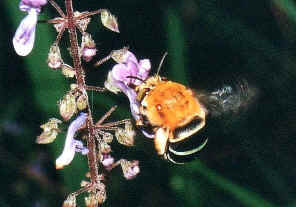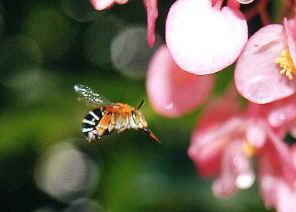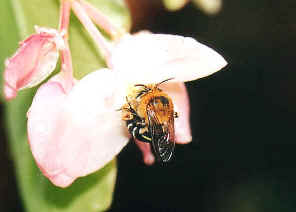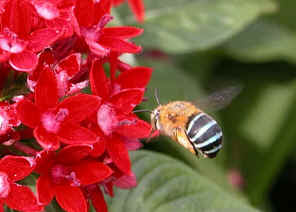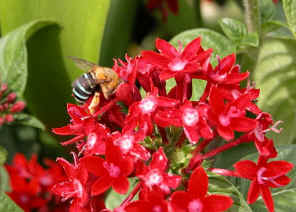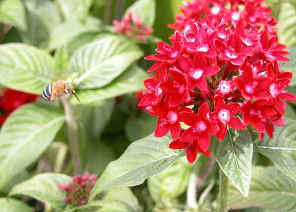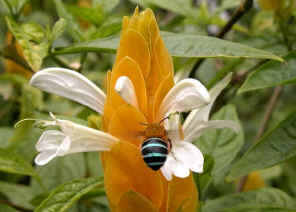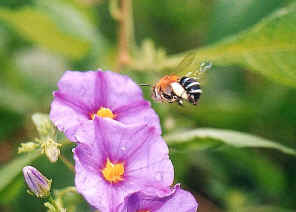Blue-banded Bee - Amegilla cingulata
Family ANTHOPHORIDAE
This page contains pictures and information about Blue-banded Bees that we found in the Brisbane area, Queensland, Australia.
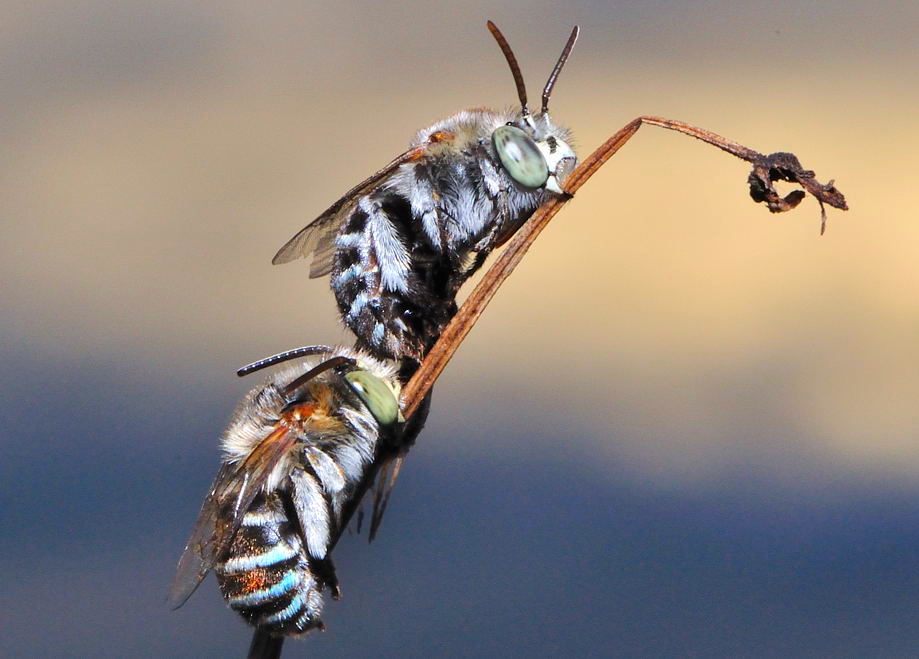
- Two Males, body length 15mm
- The thorax and head of Blue-banded Bees are covered with golden hairs and abdomen is banded with pale blue bands on black. This is a solitary bee but females may build nest together in same location with other Blue-banded Bees. Blue-banded Bees are common in Brisbane gardens.
Notice the bee's long tongue in the pictures. They use their long tongue to suck the nectar deep in the flowers. We took the above picture at Wishart in mid summer 2002 while the bee visiting its fond of lavender (Lavandula) flowers.
Blue-banded Bees are known as buzz pollinators. They use special technique to get the pollen from flowers known as buzz pollination. They hold the flowers and vibrate with loud buzz sound. The vibration excited the flower which drop the pollen onto the bees body. Other insects do not know this technique cannot get the pollen. Every time the bees rest on a flower, we can hear a short loud buzz sound.
- Blue-banded Bees are are native to Australia, although they or their close relatives can be found in other continents. They do sting but they are not aggressive, i.e., they will not attack unless disturbed.
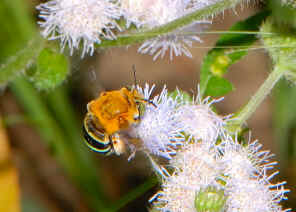
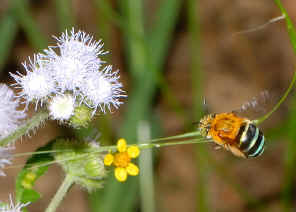
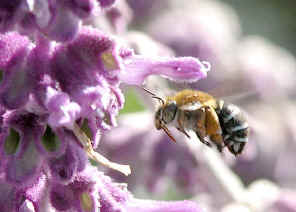
- Both Teddy Bear Bees and Blue-banded Bees fly with the dart-and-hover flight pattern, which is faster and more jerky that the common Honey Bees.
-
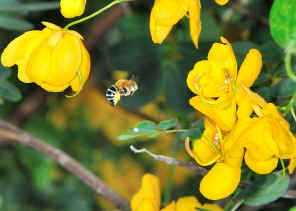
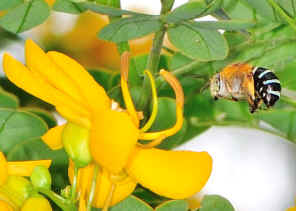
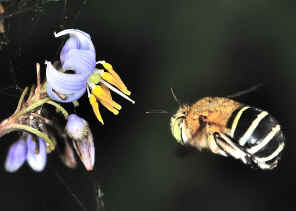
- Blue-banded Bees love blue flowers. To encourage their visit, you may grow more blue flowers in your garden.
-
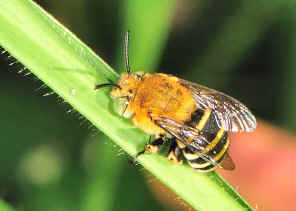
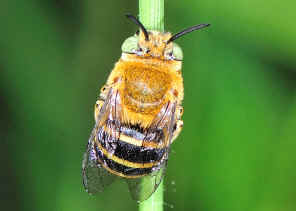
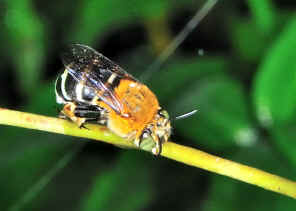
- The Blue-banded Bees in pictures above are all females.
-
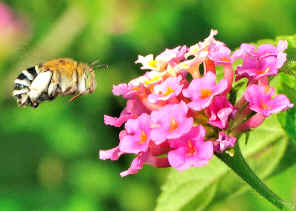
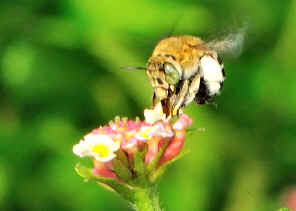
- Blue-banded Bee Males have five blue bands while females have only four. The males have the abdomen tip segment in blue while the female has this segment reduced.
-
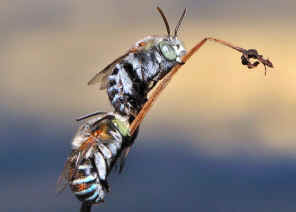
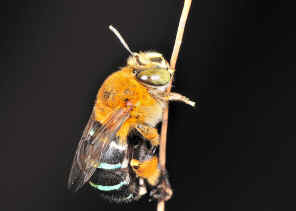
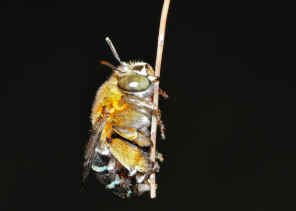
- We sometimes found them resting on dry grass stem in our backyard after sunset. Blue-banded Bees build their nests underground in soil. Male do not build nest. They will cluster for the night hanging from stems or leaves by their jaws.
-
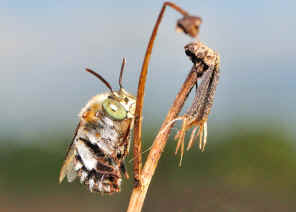
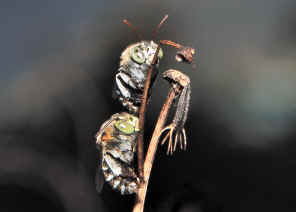
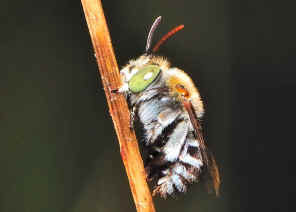
- Blue-banded Bee female build nest in soft decomposing sandstone. They also build nest in in wall of low-concrete mud brick house. Those female bees build nest and provision their brood (without the help from males). Female bees rest inside the nest during the night. Males do not build nest and they rest on grass stem in small group, as shown in the above pictures. They hold themselves on stem by their jaws.
-
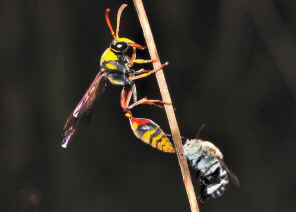
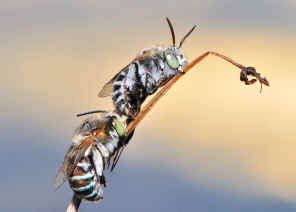
- Cuckoo Bee and 3 Blue-banded Bees Potter Wasp and Blue-banded Bee
- Photo thanks to Kylie Hungerford
- Male Blue-banded Bees rest on grass stem during evening. They are smaller size than females and relatively not so "blue". Sometimes other Hymenoptera wasp and bee species may be found resting together on the same grass stem in a small area.
- Just before sunset, those wasps and bees can be seen gathering together in a small area. Those area is usually an open area with tall grasses. The wasps and bees start resting on grass stems. They find a good position to rest for the whole night, where usually the stand alone tallest grass in the area. The favorite spot becomes quite crowded. Sometimes the insects may have body contact but there are not any conflict. The occupancies will move a bit to give some space for the new comers.
Males rest in small group
Food Plant in the wild
- There are a lot of garden flowers as the food plants for Blue-banded Bees. In the wild, we saw Blue-banded Bee fed on Bottle-brush Grass Tree flower.
- Bottle-brush Grass Tree, Saw-edged Grass Tree
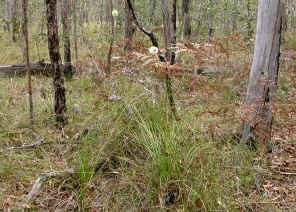
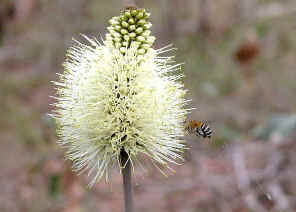
- Xanthorrhoea macronema, family Xanthorrhoeaceae
- The above pictures were taken in Mt Cotton.
- Reference:
- 1. Native Bees of the Sydney region, a field guide - Anne Dollin, Michael Batley, Martyn Robinson & Brian Faulkner, Australian Native Bee Research Centre. P52.
- 2. Insects of Australia, CSIRO, Division of Entomology, Melbourne University Press, 2nd Edition 1991, p999, Fig.42.45J.
